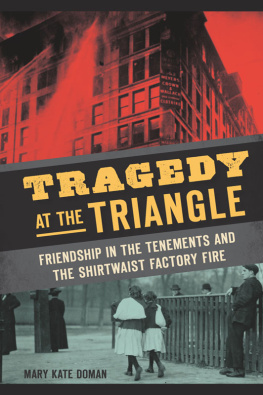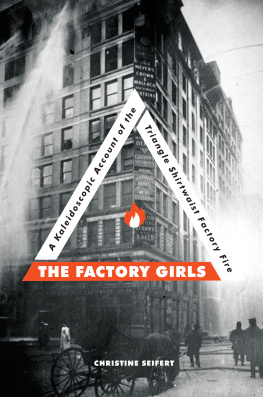Burned BeyondRecognition
The Triangle ShirtwaistFactory Fire
March 25, 1911
The Triangle ShirtwaistFactory fire of March 25, 1911was among the deadliest in UnitedStates history. The worst in the annals of New York City, itaccounted for 146 dead and 71 injured. The shirtwaist factoryoccupied the eighth, ninth and tenth floors of the Asch Building,situated just east of Washington Square Park, in GreenwichVillage.
Still standing the building is located on the northwest corner ofWashington Place and Greene Streets. Built of iron and steel itsneo-Renaissance style edifice was designed and built in 1900-01 byarchitect John M. Wooley (1865-1933), of West11 th Street. It was named for its owner Joseph Jefferson Asch(1880-1935), a physician of 780 Lexington Avenue.
Two months before theconflagration the New York City building department had certifiedthe structure fireproof. Tragically building inspectors had onlyrecently approved a situation which left all safe exits from thebuilding completely blocked.
The Triangle company madewomens blouses, waists or shirtwaists as they were called in theearly twentieth century. Most of its employees were immigrants whohad only recently arrived in America. German, Italian and EuropeanJewish girls, some as young as 13, operated the Triangle factorymachines.
Working conditions weredeplorable. Employees regularly slaved away in fourteen hourshifts, surrounded by fabric scraps. Discarded pieces of cottonfabric were haphazardly chocked in bins, baskets and on the floorsof the workplace. Worker safety was also diminished by the openflame gas lamps used to light the factory workrooms. By extendingsmoking privileges to male fabric cutters, the factory ownersfurther compromised the protection of their employees.
The fledgling InternationalLadies Garment Workers Union (ILGWU) was established during a laborstrike in 1910. By refusing to sign an agreement with the unionpromising better working conditions, Triangle ownership provedexceptional. The business refused to obligate itself to established safety rules, which other firms began to fully embrace.
The Asch Building featurednumerous tenants within a twelve story edifice. Hatters FurExchange and Martin Bates Jr. & Co. were located on the groundfloor of the building. The Fur Exchange and Bernstein and Myerswere on the floor above. Harris Brothers Clothing Manufacturing.and Maurice Bloom occupied the two floors above this.
Directly beneath the threefloors used by the Triangle Shirtwaist Factory were located theworkshops of Meyer, Cross & Wallack Company. The Trianglefactory was the only Asch Building tenant open for business on theSaturday the fire erupted.
Girls worked on the eighth,ninth and tenth floors of the Asch Building on March25 th .The owners of the Triangle Company and Blank & Harris hadrefused to give their employees a half holiday.
Throughout the spring of1911 these businesses let their workers go home at 4:45 p.m. onSaturday afternoon. On March 25 th the fire started a fewminutes before quitting time. The flames erupted just as the youngwomen were ready to shut off their sewing machines.
When fire broke out mostemployees on the eighth floor escaped as did the executives whoworked on the tenth floor. Unfortunately those on the ninth floorhad no warning that a fire had started. These employees becametrapped.
Manned by eighth floorworkers two Asch building elevators made numerous trips in adesperate attempt to save lives. Unfortunately both eventually shutdown. One of the stairwells was quickly blocked by fire and smoke.The other was secretly and unlawfully locked by companyowners.
Sixty-two Triangle employeesleaped to their deaths from windows nine stories above the ground.Others succumbed to smoke and flame inhalation. Still moreemployees jumped down elevators shafts.
Many of the factory machineswere situated near the front windows of the Asch Building.Employees worked in an area some distance from the fire escape. Thetwo elevators were located in back of the fire escapes.
At the first sight of flamesnumerous female workers rushed quickly to get to the elevators.They were joined by a few male employees who had been working inthe building lofts. Others rushed to reach the only fire escapewhich opened onto a small courtyard that was situated behind theAsch Building.
After the flames from theblaze were somewhat under control firemen entered the building.Following their hose lines upstairs they witnessed a thoroughlyhorrific sight. It caused even veteran firemen to lose theirnerve.
Only those who hadexperienced earlier New York City conflagrations, i.e the ParkAvenue Hotel fire and the Windsor Hotel fire, were even remotelyprepared for what they saw. At each entrance the firefighters weregreeted by bodies piled one on top of another. They were all thatremained of an intense and frenetic struggle of women and men toescape the flaming destruction.
The small balconies leadingfrom the Asch Buildings only fire escape were completely filledwith bodies. Others lay in the courtyard below and a sub cellarlying beneath it. Most had fallen from the fire escape trying tosave their lives. Those who survived their falls likely drowned inthe immense outpouring of water that firemen used to douse theburning structure.
From the windows of the buildingbodies were lowered one after another, a seemingly endless numberof them. Each was put in a makeshift coffin and placed on thesidewalk. A Central Office worker recorded a brief description ofeach victim.
The number of bodies beinglowered to the ground reached fifty. By this time previouslyastonished observers were seemingly inured to what was happening.Before the flames were entirely extinguished the bodies ofcountless garment workers lay on the streets outside. Fire ChiefEdward Franklin Croker (1863-1911) ordered his men to wash down thebuildings upper floors while they removed the remains of employeesstill inside.
After the fire was undercontrol five women survivors were taken to Bellevue Hospital. Twoof them died quickly. In addition to their burns both had sustainedcritical injuries from their falls from windows. Dressmaker Anna M.Hassan of 209 West 20 th Street was transported to Bellevue in a completelyhysterical condition. Observers were unsure whether she was asurvivor or had only witnessed the disaster.
By ten p.m. on March 25th amob of 10,000 persons was being pushed back by police nightsticks.The crowds anger was ignited by a directive issued by InspectorRichard Smiling Dick Walsh (1851-1922). A detective known for organizing raids onsaloons, gambling dens and bathhouses, Walsh was first appointed tothe police force in 1875.
By 1900 he rose to the rank of captain. In early 1903 Walsh hadbecome an inspector under the regime of a new New York City PoliceCommissioner. Known for employing tough tactics, Dick dared hisminions to probe the legal limits ofbrutality . After incurring a physicaldisability he had retired from the Fourth Police District on August29, 1911. Afterward Inspector Walsh had received an annual pensionequal to about half of his salary, or $1,750.
Authorities set up a special mortuaryfor relatives of the victims on the East River pier. LieutenantW.H. Sullivan, 41, headed a quickly formed body identificationsquad. Only police were permitted to cross the pier lines until allthe bodies had been accounted for
. Emptying their coffinsfollowing each trip, patrol wagons had made endless trips to andfrom Washington Place. By 10 p.m. on March25 th more than one hundred bodies were stretched on boards facingthe East River.
Many of them were soseverely burned that families were forced to examine clothing andjewelry to identify their relatives. Ethel Weiss, of 443 West49 th Street, searched for the remains of her sister Alice, 18. Shesuspected that the young woman had jumped in desperation from aninth floor window.
Next page













